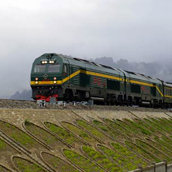A modern railway linking the two largest cities in the Tibet autonomous region started operation on Saturday, and many Tibetans said the line will greatly improve their quality of life. With an investment of 13.2 billion yuan ($2.1 billion), the 251-kilometer high-elevation railway, the second railroad in Tibet, will cut travel time between Lhasa, the regional capital, and Xigaze, the second-largest city in the region, from five hours (by bus) to about two hours. Tickets for the new line became sought-after since going on sale on Thursday night. All seats on Saturday’s service had been booked before 3 pm on Friday. The first passenger train was expected to leave Lhasa for Xigaze at 9 am on Saturday. A ticket for the trip from Lhasa to Xigaze costs 40.5 yuan, while the best seats are 175.5 yuan.
The line, which began construction in January 2011, has 14 stations and a maximum train speed of 120 km per hour. It will be capable of transporting more than 8.3 million metric tons of cargo each year. The opening of the Lhasa-Xigaze railway will “consummate the rail network in Tibet, reduce the region’s heavy dependence on road transportation, boost social and economic development as well as improve the lives of those from all ethnic groups living along the line”, said a statement from China Railway Corp, the national rail operator. The new railway will enable travelers to set out from Lhasa in the morning and arrive at scenic attractions around the Himalaya Mountains, which are located south of Xigaze, before sunset, according to People’s Daily. In the past, travelers had no choice but to make the trip on the No 318 National Highway, which is said to have many safety hazards. The average altitude of the Lhasa-Xigaze line ranges from 3,600 meters to 4,000 meters, so oxygen supply equipment has been installed under each seat to help passengers overcome altitude sickness.
“The line links Lhasa, the region’s center, with Xigaze, the most populous city in Tibet, and extends the current Qinghai-Tibet railway,” Galsang Drolma, a researcher at the China Tibetology Research Center in Beijing, said. “Its opening will significantly accelerate the speed of Tibet’s connecting with the inland transport networks.” She said Xigaze is the biggest producer of grain in Tibet and grows many other agricultural products, but farmers have suffered from poor transport conditions and were unable to do business with buyers from afar. “The line will help them sell products to the huge markets in Tibet and other provinces, thus increasing their income,” she added, noting the trains will also bring more tourists so local tourism will benefit greatly. “In addition, more travelers are coming to remote regions in Tibet, and more local residents are going out, so this will definitely promote the exchange of different cultures and create more opportunities for local people.”
Her words were echoed by Rigzin, an elderly farmer from the Gephel village of Quxu county, who said he always wanted to travel to Xigaze with his wife to go to temples there but was kept from doing so by car sickness. “Now the railway will make our dream come true. We will take the train to Xigaze after the harvest season,” he said. “We are very much looking forward to the trip because none of us has traveled by train.” Buchung, general manager of the Rinpung Darawa Barley Wine Co Ltd in Xigaze, said the railway will reduce the company’s transport costs and enable it to expand its market share in Lhasa.
Source: www.chinadaily.com.cn, 16 August 2014
